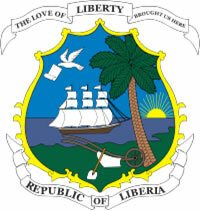Located in West Africa, Liberia borders Sierra Leone (to the northwest), Guinea (to the north), Cote d'Ivoire (to the east) and the Atlantic Ocean (to the south and west).
Acquired in the 19th century by an Organization of the United States that intended to settle free blacks in Africa or freed from US slavery, Liberia was formed by former slaves, given that its name means "country of freed”. Its independence was obtained on July 26, 1847. Of all African nations, only Liberia and Ethiopia were not colonies of European countries.
The country's economy suffers from the consequences of civil wars from 1989 to 2003, which triggered a lack of international investment and the destruction of the country's infrastructure. Another aggravating factor was the economic embargo imposed on Liberia between 2001 and 2007, as that country was accused of smuggling diamonds taken from Sierra Leone.
Agriculture is the sector that attracts the most labor. This activity is based on the cultivation of rice, cassava, coffee and cocoa. The country's main export products are rubber, wood and iron. Another important aspect for the national economy is the financial resources from ship registrations with the Liberian flag, in which the owners of these ships are attracted thanks to a fiscal regime advantageous.
People in Liberia suffer from various socio-economic problems. Unemployment affects a large part of the population; hunger and malnutrition punish the inhabitants.
For every 1,000 born in Liberia, 93 die before reaching one year of age; most residents live on less than $1.25 a day, below the poverty line.

Liberia Coat of Arms
Liberia data:
Territorial extension: 111,369 km²
Location: Africa
Capital: Monrovia
Weather: Equatorial rainy
Government: presidential republic
Administrative division: 15 counties, divided into 64 districts
Language: English (official) and regional languages
Religion: Traditional beliefs - 42.2%; Christianity - 40% (independent - 15.6%, Protestants - 12.2%, others - 14.4%); Islam - 16%; no religion - 1.5%; Bahaism - 0.3%
Population: 3,954,979 inhabitants (Men: 1,965,192; Women: 1,989,787)
Ethnic composition: Indigenous ethnic groups - 95% (main: Capeles - 19%, Bassas - 15%), Americo-Liberians - 3%, others - 2%
Demographic density: 35.5 inhab/km²
Average annual population growth rate: 4.2%
Population residing in urban areas: 60.85%
Population residing in rural areas: 39.15%
Illiteracy: 44.5%
Undernourished population: 40%
Life expectancy at birth: 45.1 years
Households with access to drinking water: 64%
Households with access to a health network: 32%
Human Development Index (HDI): 0.300 (low)
Currency: Liberian Dollar
Gross Domestic Product (GDP): 870 million dollars
GDP per capita: 195 dollars
External relations: World Bank, IMF, UN, AU.
By Wagner de Cerqueira and Francisco
Graduated in Geography
Brazil School Team
countries - geography - Brazil School

